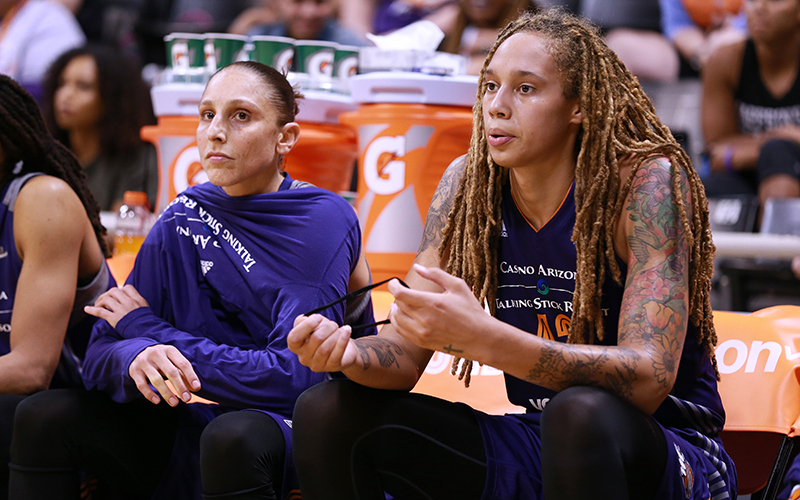PHOENIX – Overuse injuries are often attributed to factors such as specialization in youth sports. But the unique circumstances of women’s professional basketball has made WNBA players especially susceptible.
Will the league’s new collective bargaining agreement change that?
The recent deal provides a 53% increase in total cash compensation to players, and the game’s stars – the Mercury’s Diana Taurasi and Brittney Griner, for example – will be able to earn compensation in excess of $500,000, according to details provided by the league.
In 2019, the median salary in the WNBA was approximately $75,000 per year, with a maximum salary of $110,000, according to Forbes. It’s a fraction of the salaries NBA players are paid, which start at a minimum of $582,180. Although NBA teams play 82 regular-season games and WNBA teams play only 36, Forbes notes that even NBA referees were paid more on average than WNBA players in 2018.
As a result, many WNBA players compete from May to September in the U.S., and then play professionally from October through April overseas, where salaries are much more lucrative.
Taurasi and Griner, for example, have made about $1.5 million each annually in Russia.
“A lot of people go overseas to work on their game,” Mercury coach Sandy Brondello said. “But as you get older, it can become a bit of a grind. So these (increased salary) opportunities allow them not to do that.”
While playing overseas during their WNBA offseason has been great for bank accounts of professional players, their bodies often pay the price. For instance, Seattle’s Breanna Stewart won the WNBA’s Most Valuable Player in 2018, then was named regular-season MVP of the EuroLeague. But she missed all of the 2019 WNBA season after rupturing her achilles tendon in a EuroLeague game while playing for the Russian club Dynamo Kursk.
Dr. Anikar Chhabra, chair of the sports medicine division at the Mayo Clinic Sports Medicine Center in Tempe, said he recommends that his patients take an entire month off from their sport during the year because doing the same thing to the same muscle or joint over and over again can cause repetitive injuries.
However, he said it is harder for professional athletes, such as NBA and WNBA players, to take an entire month off because their sport is their job. “Load management” – monitoring players and giving them practice or game days off to recover – is a trending topic in the NBA.
Chhabra believes having an offseason can reduce overuse issues.
“You’ve got to take the offseasons off,” Chhabra said. “The problem with the WNBA players … is they’re going to Europe and playing because that’s where they make their money.
“And now you’re starting to see people taking off the WNBA season and just playing in Europe, like Diana Taurasi did (in 2015) … She can do that because she has the money to do that. Most people can’t do that.
“So that’s why we’re seeing the rash of injuries In the WNBA players more than the NBA players even, because these girls are going year round. The NBA, these guys are taking three, four months off from basketball every year, in the offseason. And women, they’re not getting that.”
The new CBA has Chhabra hoping players will stick to one league.
“And that’s what I’d recommend,” Chhabra said. “I’d recommend playing in a league. It’s hard to play two different seasons and not have the time for your body to recover. And I know the European leagues will say, get over here when the season ends. And if you’re in the playoffs in Europe and get to the WNBA late … they’re going from one league right to the next. (They’re) not getting a chance for their body to recover. And so it’s an epidemic.”
Dr. Matt Anastasi, a primary care support specialist with the Mayo Clinic, said he would let players make their own decisions about playing abroad in the WNBA offseason.
“I would certainly give it up to them,” Anastasi said. “I mean, obviously, the real world comes with real world responsibilities, right? Paying bills, paying mortgages, paying for all those things.
“So a lot of times there’s a financial need to do that. So I think the fact the new CBA is going to bring more money … is great. And I think you’ll probably see less people going abroad to play. But I think ultimately for them, even if someone’s not playing abroad, they’re still playing, right? But I think sometimes there’s a financial motivation to play both, because they feel the need … to do that in order to make a living.”
UCLA women’s basketball legend and Phoenix Mercury executive Ann Meyers Drysdale said it is the “goal” of the new CBA for players to stay in the WNBA and not need to compete in two leagues year round.
Still, the money is a draw. Stewart, despite her injury, re-signed last week with the Seattle Storm – and also signed with UMMC Ekaterinburg, another team in Russia.”

